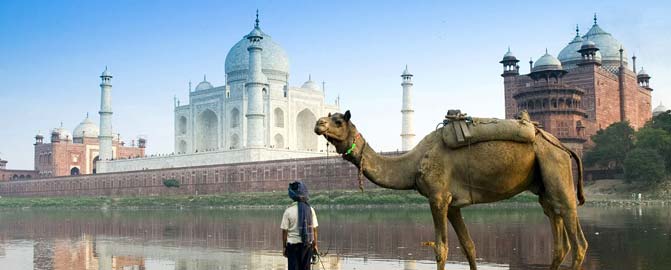Day 01: Flight to Dehli

| Group Size : | 02 - 14 people | 600m | |
| Destination : | India | Fitness level : | Leisurely Plus |
| Trip Season : | All Season ( Jan - Dec) | Departure from : | Delhi |
| Meals : | Breakfast |
| Accomodation : | 3 star standard hotel |
| Trip Mode : | Hotel |
Arrival in Delhi. Meet staff then transfer. Transfer to the hotel. Overnight in Delhi at the hotel
After breakfast visit the Red Fort (or Lal Qil'ah), symbol of the Mughal power, then the Jama Masjid mosque, the largest mosque in India, which built in the 16th century. and experience in a rickshaw visit the narrow streets of Chandni Chowk, an amazing blend of history and modernity, and visit Raj Ghat, the cremation site of Mahatma Gandhi. Continuation by visiting the India Gate, the war memorial and the imperial residence of the British Vice-Kings, now the official residence of the President of the Republic of India. Then visit the Lotus Temple and Qutb Minâr, one of the tallest towers built in the 12th century. End of the tour with the visit of the tomb of Humâyûn, complex of Mughal architecture. Return to the hotel.
Overnight in Delhi at the hotel.
After breakfast, departure to Jaipur, the pink city and capital of Rajasthan, 258 km from Delhi. Known as one of the most lively and pleasant cities in India, Jaipur attracts many visitors each year. To begin, visit the temple Laxmi Narayan, immense temple of marble built in 1988, on a hill of Jaipur. Then visit the market of Jaipur, known for its local and traditional products. Finally, take a look at the stunning façade of the Palace of the Winds, the most romantic and well-known monument in the city.
Overnight in Jaipur.
Breakfast at the hotel and, in the morning, excursion to the Amber Fort, ancestral home of the maharajas of Jaipur, with possibility of climbing the fort on the back of an elephant. Upon return to Jaipur in the afternoon, visit the splendid City Palace - the official residence of the royal family - on 7 floors and the astounding Jantar Mantar Observatory. End of the day free to stroll through the bazaars of the old town. Jaipur is the perfect place to buy souvenirs.
Overnight in Jaipur.
Departure by road to Agra, 250 km past Fatehpur Sikri, the former abandoned capital. Visit the Palace, meeting rooms and the spacious Panch Mahal with its 5 floors bunk like a chateau of maps and its 176 columns all carved differently. Finally, discover the tomb of Salim Chisti, Sufi saint of the Mughal Empire, then Buland Darwaza, a magnificent 54 m structure built of red sandstone with pink marble decorations.
Overnight in Agra.
Breakfast at the hotel. Visit of the Taj Mahal, a mausoleum built between 1631 and 1653 on the initiative of the Mughal Emperor Shah Jahan for his late wife Mumtaz Mahal and a UNESCO World Heritage site since 1983. Masterpiece of Muslim art, The Taj Mahal is the fruit of 22 years of work by 20,000 artisans mobilized. Continuation of the walk with the visit of the Red Fort of Agra, transformed into a palace by the emperor Akbar in 1565 and enlarged by successive Mughal emperors. A symbol of the excellence of Mughal architecture, the fort also serves as an observation point for admiring the Taj Mahal. Visit of the mosque and the tomb of Itamad-ud-Daula, built by the Empress Noorjehan in memory of her father.
Overnight in Agra.
Orchha- Home Stay direct by Asha friends of Orcha) (Homestay - a double room in a local family in a comfortable setting) to have a better chance to stay with family and see the preparation of local food and Interact with local.
Orchha is one of the few places in India that combines natural beauty, aesthetic heritage of history and a certain authenticity. Orchha is in transition between village and city, and several of its small temples are in the open field. Life in Orchha revolves around the temple of Ramraja, and everyone can see how Hinduism is still alive today. Transfer to Khajuraho - Overnight at hotel.
The temples of Khajuraho are one of the most remarkable sites of India. These buildings of astonishing beauty testify to a historical and poetic genius which solicits our imagination. The temples of Khajuraho were built by the Chandela dynasty. If the beauty and dimensions of the temples are an eternal subject of astonishment, one is lost in conjecture as to why this place was chosen to receive them. The temples of Khajuraho are still one of the greatest artistic wonders in the world.
Overnight at the hotel. In Khajuraho.
Departure by train to Vârânasî. Upon arrival, transfer to hotel and visit of Sārnāth, a Buddhist city located about ten kilometers north of Varanasi. It was at Sārnāth that Buddha gave his first teaching after reaching the state of awakening. During the day, visit high places of Buddhism, including a magnificent museum.
Overnight in Vârânasi in the hotel.
Departure early in the morning for the visit of Vârânasî, during a boat trip on the Ganges to see the sunrise. On the sacred river are the rituals of the Hindus, the traditional cremation, the innumerable ghats (marches which cover the banks of the rivers or the banks of the basins in India), the sumptuous Nepalese temple Wooden construction, and its grant as well as Manikarnika Ghat, undoubtedly one of the oldest cremation ghats of the city. An extraordinary spectacle not to be missed, in a supernatural light. Continuation with the visit of the Kashi Vishwanath, temple dedicated to the god Shiva.
Overnight in Vârânasi in hotel.
